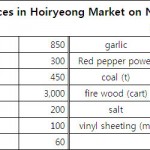Click image to see all the prices
According to the Daily NK:
Winter is a tough time for average North Koreans, with a number of demanding economic issues to deal with. This year, as the traditional season for making “kimchi”, the indispensible side dish on any Korean dining table, approaches, ingredient prices in the market are become a focus for concern.
This is only the second winter since the currency redenomination of November 30th, 2009. Since then, prices have fluctuated unpredictably throughout the year due to various economic and political uncertainties. As a result, the overall situation now is not radically different from the period of high prices before the redenomination.
According to one inside source from North Hamkyung Province who spoke with The Daily NK on November 9th, “Wealthy people will have already finished preparations for heating and kimchi by the end of October; however, those belonging to underprivileged groups have not even prepared the kimchi for winter yet.”
According to the source, Chinese cabbage, the core constituent of the most popular form of kimchi, was being sold for as much as 100 won/kg and white radish for 60 won/kg in the market in Hoiryeong in North Hamkyung Province in recent days. The core seasonings for many forms of kimchi, garlic and dried red chili pepper powder, were being sold for 3,800 and 4000 won/kg respectively.
On October 25th, 2009, shortly before the currency redenomination, Chinese cabbage was being sold for 200 won, white radish for 150 won, garlic for 3,000 won and dried red pepper powder for 7,000 won in the same market. Thus, many of the effects of the currency redenomination appear to have been disguised by price inflation.
For a family of four, 500kg of Chinese cabbage and 300kg of white radish is needed to see them through the winter. To meet that requirement in full would, at current prices, require 50,000 won for cabbage and 18,000 won for white radish. Add in the price of the seasonings, including salt and green onion in addition to garlic and red pepper powder, and the total price is close to 100,000 won.
Other aspects of winter life are no less problematic. Heating is one example. For a household burning coal, a couple of tons are burnt between November and March. Currently, the price of coal in Hoiryeong market is around 20,000 won per ton. Meanwhile, houses which are heated with wood need roughly enough to fill two ‘Seungli-58’ trucks, or approximately five tons. Such a quantity costs 50,000~60,000 won (7,000 won/cart in Hoiryeong) at the current market price.
Another key factor in a comfortable winter is vinyl for shielding houses against the winter wind. This is now selling for 400 won/m. Most North Korean houses have three windows, to which people living in North Hamkyung and Yangkang Province apply two layers of vinyl, meaning that each household needs ten meters on average, including that to cover the door.
Therefore, taking Hoiryeong market as the average, people need a minimum of 150,000 won to prepare for the winter. When the average North Korean worker’s salary is between 1,500~3,000 won, it is clearly very hard for most to endure the winter in comfort.
According to the source, “The conditions in a household are revealed by the amount of dried red pepper powder in their winter kimchi. An affluent family’s kimchi is red and appetizing, but an poor family’s kimchi is like white kimchi with a few pieces of dried red pepper powder on the top.”
Read the full story here:
The Chilly Economic Wind of Winter
Daily NK
Yoo Gwan Hee
11/10/2010

